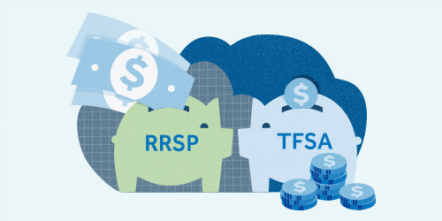
TFSA and RRSP: If you’re looking for a way to ensure financial stability and build a solid future in Canada, you’ve probably heard of the Tax-Free Savings Account (TFSA) and the Registered Retirement Savings Plan (RRSP). These are two of the main tools offered by the Canadian government to help citizens save and invest, with tax benefits that can significantly boost your financial results over time.
In this guide, we’ll explain clearly and in detail how these programs work, who can benefit from them, their rules, and how you can maximize the advantages for your financial and retirement needs.
What is the TFSA (Tax-Free Savings Account)?
The TFSA is a tax-free savings account that allows you to save money and grow your investments without having to pay taxes on the earnings generated (such as interest, dividends, and capital gains). This program was created in 2009 and has become an essential tool for Canadian residents who want to save for various goals, whether they are short-, medium-, or long-term.
How the TFSA Works:
✅Contributions: You can contribute annually up to the limit set by the government. In 2024, that limit is CAD 6,500. If you don’t use your full contribution room in a given year, you can “carry forward” the unused amount to future years.
✅Tax-Free Growth: All growth within the TFSA (such as interest or stock dividends) is tax-exempt. This means you won’t pay taxes when you make withdrawals, nor on the earnings.
✅Flexible Withdrawals: One of the biggest advantages of the TFSA is that you can withdraw money at any time, without restrictions or tax penalties. Moreover, the amount you withdraw can be re-contributed starting in the following year.
Who Can Open a TFSA?
To open a TFSA, you need to be a permanent resident of Canada, be at least 18 years old, and have a Social Insurance Number (SIN).
Key Rules of the TFSA:
It’s essential to monitor your contributions, as exceeding the annual limit will result in a 1% penalty per month on the excess amount. The TFSA can be used for various purposes—emergencies, buying goods, travel, or simply as a long-term savings account. It’s a versatile account that adapts to your financial goals.
What is the RRSP (Registered Retirement Savings Plan)?
The RRSP is a registered account specifically designed to help Canadians save for retirement. The main benefit is the tax deduction: contributions to the RRSP reduce your taxable income in the year they are made, which can result in a significant tax refund.
How the RRSP Works:
✔️Tax-Deductible Contributions: Contributions to an RRSP are deducted from your income tax, reducing the amount you need to pay in the year the contribution is made. This is especially advantageous if you’re in a higher tax bracket.
✔️Tax-Deferred Growth: Money invested in an RRSP grows tax-free until you withdraw it. This means your investments can grow faster, as taxes are deferred until the future, when you withdraw in retirement.
✔️Annual Contributions: The contribution limit for the RRSP is 18% of your annual income, up to the maximum set. In 2024, the maximum contribution amount is CAD 31,560.
Who Can Contribute to an RRSP?
Anyone who has taxable income in Canada can open and contribute to an RRSP. The higher your income, the greater the immediate tax benefit, as you can deduct your contributions from your taxable income.
Key Rules of the RRSP:
You can contribute to an RRSP until the end of the year you turn 71, giving you a long window to save for retirement. Withdrawals from an RRSP are taxed as income in the year they are made. However, there are two exceptions: the Home Buyers’ Plan (HBP) allows you to withdraw up to CAD 35,000 tax-free for purchasing your first home, and the Lifelong Learning Plan (LLP) lets you use RRSP funds for education.
By age 71, you must convert your RRSP into a Registered Retirement Income Fund (RRIF) or purchase an annuity to start receiving regular income during your retirement years.
How to Choose Between the TFSA and RRSP?
Choosing between the TFSA and RRSP depends on your financial goals and current income situation. Here are some points to help you decide:
When the TFSA is Better:
✅You want flexibility to access your money at any time, without penalties or taxes.
✅Your annual income is lower, or you’ve already maximized your RRSP contributions.
✅You’re saving for something beyond retirement, such as emergencies, a vacation, or purchasing a car.
When the RRSP is Better:
✅You’re focused on saving for retirement and want to reduce your tax burden today.
✅You’re in a higher tax bracket and can benefit immediately from the tax deduction on RRSP contributions.
✅You want to use the HBP to finance the purchase of your first home without paying taxes.
Using the TFSA and RRSP Together!
One of the most effective strategies is to use both the TFSA and RRSP for different financial goals. For example, you can use the TFSA to build an emergency fund and save for medium-term goals, while the RRSP is reserved exclusively for retirement planning.
Maximize Your Tax Benefits and Achieve Your Goals with TFSA and RRSP!
Both the TFSA and RRSP offer significant tax advantages that can help you reach your financial goals, whether for saving, investing, or retirement. Understanding how each works and which one best fits your personal situation is essential for making informed financial decisions.
Whichever you choose, remember to track your contribution limits and consult a financial advisor to personalize your savings strategy and ensure you’re making the most of these programs offered by the Canadian government.
